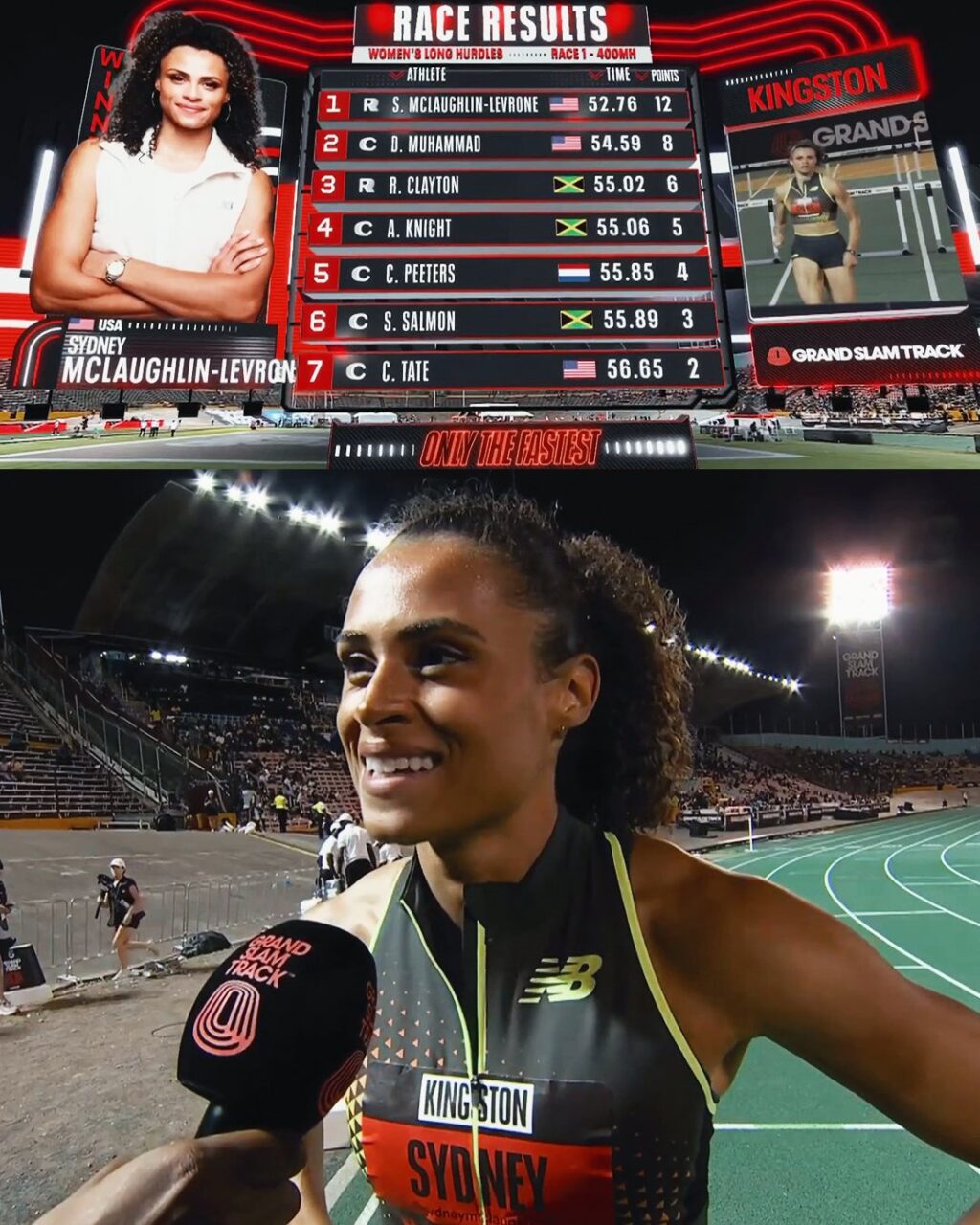
Failing Sydney McLaughlin-Levrone & Co. Grand Slam League Fall to Desperate Ways to Save Face
By Sehaj Kour, Modified April 6, 2025 | 12:42 AM EDT
On March 27, 2025, Michael Johnson boldly stated, “There are 2.5 billion people around the world who are interested in running or watching track,” adding that track and field lacked a home to showcase the world’s fastest athletes. He envisioned Grand Slam Track (GST) as that much-needed stage, an event that could bottle the excitement of the Olympics and make it available to the world. Johnson, a four-time Olympic gold medalist, was not shy about his high hopes. “This is going to be track’s equivalent of UFC and Formula One,” he declared. GST was supposed to change the game, drawing attention to track and field like never before, with all-star athletes and thrilling events for fans worldwide.
But on April 4, 2025, when the lights came up at Kingston’s National Stadium for the debut of the Grand Slam Track series, reality came crashing down hard. The event, which promised to be a game-changer for the sport, faced a glaring issue—empty seats.
Despite a roster packed with track legends, including Sydney McLaughlin-Levrone, Gabby Thomas, Marileidy Paulino, Oblique Seville, and Danielle Williams, the turnout was a stark disappointment. With a capacity of 35,000, the stadium was barely filled, and the grandstands appeared mostly empty. Just 6,000 spectators showed up on opening night, casting a shadow over what was supposed to be a groundbreaking moment for track and field.
The buzz leading up to the event had been substantial. Promos flooded social media, and fans were eager to see these athletes compete on a world-class stage. The high-powered athletes, including McLaughlin-Levrone and Thomas, were touted as the stars who would propel GST into the global spotlight. Yet, when the races began, the silence in the stadium spoke volumes. The lack of energy in the stands was in stark contrast to the immense talent on the track.
A Disastrous Start
The opening event of GST featured some of track and field’s brightest stars. Gabby Thomas took to the track for the women’s 200-meter race, a highly anticipated event. As the race unfolded, Thomas surged from behind, crossing the finish line with a time of 22.62 seconds to claim victory. Olympic champion Marileidy Paulino finished second, and Dina Asher-Smith took third. It was a thrilling contest, but when the race ended, there was barely a sound. The absence of a crowd’s roar was almost surreal, especially considering the magnitude of the competition. This moment of silence was a painful reminder that the event had failed to capture the attention of the spectators it had so desperately sought.
While GST had managed to attract star athletes, the crowd’s response—or lack thereof—was a stark reminder that track and field might not be as universally appealing as Johnson had hoped. The event was promoted as something that could rival the spectacle of Formula One and the UFC, but the reality on the ground was quite different.
Desperate Measures and the Struggle to Save Face
The low turnout led organizers into a frenzy, scrambling to fill the empty seats and save face. Just a day after the lackluster opening, Jamaican star Ackera Nugent posted an unusual message on Instagram. The post, which later garnered attention from World Athletics, offered free access to the bleachers for anyone arriving between 3:00 PM and 5:00 PM, with ticket fees waived for the time being. The move was not a strategic marketing play, but rather a desperate attempt to fill the stadium and mask the optics of the underwhelming crowd. It was clear that GST was in survival mode.
Nugent’s post was just the beginning. A few days later, another unexpected move came from the Inter Secondary School Sports Association (ISSA), which reached out to coaches across Jamaica. The ISSA offered all schools free access to the bleachers for GST’s weekend events, hoping to draw young, energetic fans who could bring life to the stadium. It was a clear attempt to leverage the passionate love for track and field in Jamaica and fill the seats with the next generation of fans.
“Just turn up at the bleachers, and you will be allowed in,” the message read. In many ways, this was a savvy play to tap into the local culture and fanbase that had made Jamaican sprinters household names around the world. However, it also signaled that GST’s grand debut had fallen short of expectations, and the event’s survival now hinged on appealing to a younger audience.
The Power of Star Power vs. Fan Engagement
GST’s appeal on paper had seemed undeniable. With names like McLaughlin-Levrone, Thomas, Paulino, and Seville, the series was supposed to offer an exciting new platform for track and field. Michael Johnson had envisioned a spectacle that could unite fans from around the world, giving track athletes the kind of visibility typically reserved for athletes in more mainstream sports like football and basketball. The format of GST was unique: athletes would be required to compete in multiple races, offering fans a deeper connection with the competitors. This was something that had never been done in the sport, and it was positioned as the defining characteristic of GST’s appeal.
But despite the star-studded lineup and the innovative format, GST struggled to ignite the passion it had hoped for. In the world of professional sports, the athletes may be the biggest draws, but fan engagement is equally critical. Simply having the world’s top athletes on the track isn’t enough to create the spectacle that will attract a global audience. A sense of community, excitement, and shared energy is essential—and that’s exactly what was missing in Kingston’s National Stadium.
It’s not that track and field has no appeal; the popularity of events like the Olympics and World Championships proves that there is an audience for the sport. However, GST’s attempt to create a year-round, high-profile event faced an uphill battle in terms of generating consistent fan interest. The sport, unlike the UFC or Formula One, does not yet have the kind of pervasive global appeal needed to carry an event like GST throughout the year. The sense of urgency and passion that comes with a once-every-four-year spectacle like the Olympics simply cannot be replicated week after week in a sport that lacks the same level of year-round fan engagement.
What Went Wrong?
There are several reasons why GST’s debut faltered. First and foremost, the event overestimated the existing global fanbase for track and field. While Olympic moments are monumental, track events on their own don’t necessarily generate sustained excitement. In contrast, sports like the UFC or Formula One have succeeded because of their broader entertainment appeal, featuring not only athletes but also storylines, rivalries, and year-round media exposure.
Additionally, GST’s decision to hold its inaugural event in Jamaica, a country with strong track and field roots but a limited fanbase beyond the region, may have limited its ability to capture a wider global audience. The lack of local engagement was further compounded by the decision to offer free tickets to students, signaling an absence of confidence in the event’s ability to generate ticket sales on its own.
Finally, there’s the question of timing. The world of track and field is already packed with events. Between the Diamond League, the World Championships, and the Olympics, there’s a crowded calendar. GST, despite its novel approach, may have failed to differentiate itself enough from these established competitions to create the kind of lasting impact Johnson envisioned.
The Road Ahead: Can GST Recover?
It’s too early to write off Grand Slam Track entirely. The series has the potential to capture the imagination of fans if it can develop a more strategic plan for engaging audiences and build the kind of year-round excitement that can make it a global phenomenon. With the right adjustments, GST could become a platform that showcases the best of track and field, not just as an Olympic spectacle but as a sport capable of holding its own year-round.
For now, however, the jury is still out on whether GST can overcome its rocky start and fulfill its ambitious goals. The series has the talent, the star power, and the vision—but the real question remains: will it be able to turn that vision into a sustainable reality, or is it destined to be another fleeting idea that never fully realizes its potential?
Conclusion
Grand Slam Track’s debut on April 4, 2025, revealed the challenges of creating a new platform for track and field. The high expectations surrounding the event, paired with its poor turnout, revealed that while the potential for GST is there, it is not yet fully realized. Michael Johnson’s dream of transforming track and field into a year-round global spectacle will require more than just star power—it will need consistent engagement, a robust fanbase, and a clear identity that sets it apart from other sports. Only time will tell if GST can recover and fulfill its promise of being the “UFC or Formula One” of track and field.





